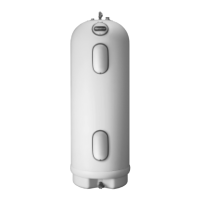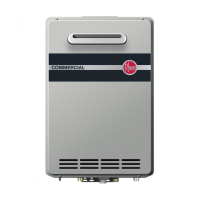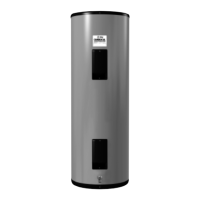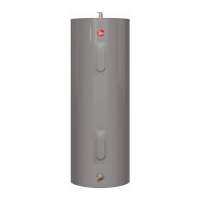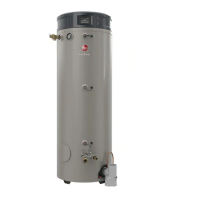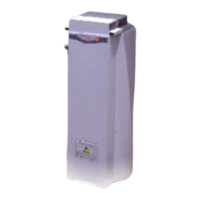34
INSTALLATION INSTRUCTIONS
Venting for Direct-Vent Water Heater
DANGER: Failure to properly vent the water
heater to the outdoors as outlined in this Venting
section will result in death or serious personal injury.
To avoid the risk of fire, explosion, or asphyxiation
from carbon monoxide, NEVER operate the water
heater unless it is properly vented and has adequate
air supply for proper operation as outlined in this
Venting section. This water heater must have air
supply connected and terminated to the outdoors.
WARNING:
Refer to page 29 for required clearances to
combustible materials. Improper clearances can cause
explosion or fire resulting in death, personal injury,
and/or product damage.
CAUTIONS:
•
Check to make sure flue gases do not recirculate into
the air intake terminal when using direct venting. If the
water heater is having service issues, flue recirculation
may be a contributing factor.
• Even when the minimum vent terminal separation
distances are followed, recirculation may still occur
depending upon the location outside the building,
the distance from other buildings, proximity to
corners, weather conditions, wind patterns, and
snow depth.
• Periodically check to make sure that flue
recirculation is not occurring. Signs of flue gas
recirculation include frosted or frozen intake
terminals and condensate in the intake terminal and
venting system.
• Correction to flue recirculation may involve angling
the intake away from the exhaust terminal and
increasing the distance between them. Check to
be sure the intake and exhaust terminals are not
obstructed, especially during periods of below-
freezing weather.
Venting Requirements
The installation of venting must comply with national
codes, local codes, and the vent manufacturer’s
instructions.
The vent exhaust and air intake must terminate outside
as described in these instructions. DO NOT vent this
water heater through a chimney. It must be vented
separately from all other appliances.
NOTICE: The unit can be vented using only the
following approved vent pipe material.
Use only 2- or 3-inch diameter pipe. Refer to local codes
for restrictions on the use of PVC, CPVC, or ABS pipe
and fittings. All exhaust venting materials for product
installed in Canada must meet ULC-S636.
Acceptable materials or equivalent:
PVC (Schedule 40, ASTM D-1785)
CPVC (Schedule 40, ASTM F-441)
ABS (Schedule 40, ASTM D-2661)
(not permitted for exhaust vent in Canada)
The fittings, other than the VENT TERMINAL,
should be equivalent to the following:
PVC (Schedule 40 DWV, ASTM D-2665)
CPVC (Schedule 40 DWV, ASTM F-438)
ABS (Schedule 40 DWV, ASTM D-2661)
(Not permitted in Canada)
Category III Stainless Steel (Proper transition part
required)
DO NOT USE Schedule 20, Cell Core, Drain Pipe,
Galvanized, Aluminum, or B-Vent.
Recommended Vent Lengths
Before starting the vent installation, careful planning
should be given to the routing and termination of the
vent pipes. The length of the vent pipes (inlet and
outlet) should be kept to a minimum. Also, see pages
37–38 and 44 for vent terminal placement. Refer to the
maximum and minimum vent length charts for the pipe
sizes that can be used and the total equivalent length
of pipe that can be used. Do not exceed equivalent
length of pipe in maximum vent length chart.
Maximum Vent Length (intake/outlet):
Number of
90° Elbows
Maximum Length
of 2" Straight Pipe
Maximum Length
of 3" Straight Pipe
1 5.0 ft. (1.5 m) 38.0 ft. (11.6 m)
2 3.5 ft. (1.0 m) 36.5 ft. (11.1 m)
3 2.0 ft. (0.6 m) 35.0 ft. (10.6 m)
4 Not available 33.5 ft. (10.2 m)
5 Not available 32.0 ft. (9.8 m)
6 Not available 30.5 ft. (9.3 m)
The system will not operate if there is excessive
restriction (pressure drop) in the venting system. Use
the chart above to calculate the maximum pipe run
length with the required number of elbows (e.g., a
maximum 38 ft. [12 m] of 3" vent pipe may be used
provided there is only one 90° elbow in the system).
A 90° elbow is equivalent to 1 ft. 6 in. (0.5 m) of
straight pipe. A 45° elbow is equivalent to 9” (0.25 m)
of straight pipe.
The vent termination does not count as part of the
straight pipe equivalent when determining the total
vent length.
Minimum Vent Length:
Number of
90° Elbows
Minimum Length
of 2" Straight Pipe
Minimum Length
of 3" Straight Pipe
1 1.0 ft. (0.3 m) 1.0 ft. (0.3 m)
Venting
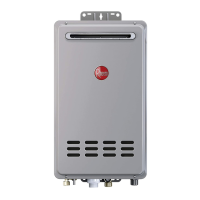
